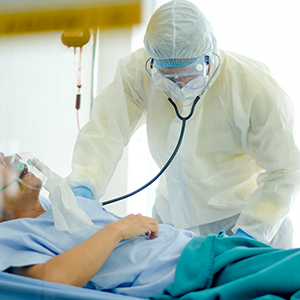Predictors of post COVID complications in patients admitted with moderate to severe COVID symptoms: A single center, prospective, observational study

Submitted: April 29, 2022
Accepted: July 7, 2022
Published: July 20, 2022
Accepted: July 7, 2022
Abstract Views: 1507
PDF: 529
Publisher's note
All claims expressed in this article are solely those of the authors and do not necessarily represent those of their affiliated organizations, or those of the publisher, the editors and the reviewers. Any product that may be evaluated in this article or claim that may be made by its manufacturer is not guaranteed or endorsed by the publisher.
All claims expressed in this article are solely those of the authors and do not necessarily represent those of their affiliated organizations, or those of the publisher, the editors and the reviewers. Any product that may be evaluated in this article or claim that may be made by its manufacturer is not guaranteed or endorsed by the publisher.
Similar Articles
- Muhammad Ijaz, Muhammad Jaffar Khan, Jawad Khan, . Usama, Association of clinical characteristics of patients presenting with influenza like illness or severe acute respiratory illness with development of acute respiratory distress syndrome , Monaldi Archives for Chest Disease: Vol. 87 No. 1 (2017)
- Sergio C. Conte, Giulia Spagnol, Marco Confalonieri, Beatrice Brizi, Deep sedation versus minimal sedation during endobronchial ultrasound transbronchial needle aspiration , Monaldi Archives for Chest Disease: Vol. 88 No. 3 (2018)
- Vittorio Palmieri, Antonio Palermo, Patients’ self-evaluation of symptoms, signs and compliance to therapy for heart failure surveillance: A pilot study on identification of worsening heart failure , Monaldi Archives for Chest Disease: Vol. 88 No. 2 (2018)
- Neeta Singla, Amitesh Gupta, U.K. Khalid, Ravindra Kumar Dewan, Rupak Singla, Clinical profile, risk factors, disease severity, and outcome for COVID-19 disease in patients with tuberculosis on treatment under the National Tuberculosis Elimination Program: a cohort of 1400 patients , Monaldi Archives for Chest Disease: Early Access
- N. Facciolongo, M. Patelli, S. Gasparini, L. Lazzari Agli, M. Salio, C. Simonassi, B. Del Prato, P. Zanoni, Incidence of complications in bronchoscopy. Multicentre prospective study of 20,986 bronchoscopies , Monaldi Archives for Chest Disease: Vol. 71 No. 1 (2009): Pulmonary series
- Fabrizio Corsini, Anna Scaglione, Maria Iacomino, Giuseppe Mascia, Saverio Melorio, Carmine Riccio, Salvatore Romano, Alfredo Vetrano, Silvana Celardo, Giancarlo Corsini, Carmelo Chieffo, Acute myocardial infarction in the elderly. A case-control study with a younger population and review of literature , Monaldi Archives for Chest Disease: Vol. 66 No. 1 (2006): Cardiac series
- Panagiotis Hountis, Maria Chounti, Chilaiditi’s sign or syndrome? Diagnostic question in two patients with concurrent cardiovascular diseases , Monaldi Archives for Chest Disease: Vol. 87 No. 2 (2017)
- Alessandro Mezzani, Francesco Cacciatore, Raffaella Catanzaro, Alessandra Gualco, Daniela Guzzetti, Dario Leosco, Mauro Monelli, Franco Tarro Genta, Paolo Totaro, Egidio Traversi, Emanuela Zanelli, Pantaleo Giannuzzi, A multicenter, randomized, controlled trial on short-term feasibility and impact on functional capacity, symptoms and neurohumoral activation , Monaldi Archives for Chest Disease: Vol. 82 No. 1 (2014): Cardiac series
- Carlo Lombardi, Marco Sbolli, Dario Cani, Garbriele Masini, Marco Metra, Pompilio Faggiano, Preoperative cardiac risks in noncardiac surgery: The role of coronary angiography , Monaldi Archives for Chest Disease: Vol. 87 No. 2 (2017)
- Unnati Desai, Ketaki Utpat, Aravind Raj, The impact of the COVID-19 pandemic on the profile of interstitial lung disease presenting to the pulmonary medicine department of a tertiary care center in western India , Monaldi Archives for Chest Disease: Early Access
You may also start an advanced similarity search for this article.

 https://doi.org/10.4081/monaldi.2022.2307
https://doi.org/10.4081/monaldi.2022.2307





